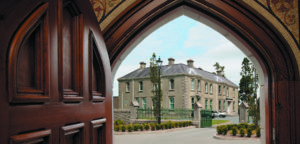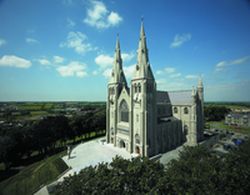LAUNCH OF
CATHOLIC REVIVAL IN THE NORTH OF IRELAND – 1603-1641
BY REV BRIAN MacCUARTA
ADDRESS BY
ARCHBISHOP SEÁN BRADY
O FIAICH LIBRARY & ARCHIVE
SATURDAY 17 NOVEMBER 2007
About thirty years ago I was an active member of Cumann Seanchais ni Brefini and made many friends. In fact, at one stage, I was Editor of its journal Breffini. Not a very efficient editor I may add, partly because I was distracted by many other things – football being one of them I would say. But I remember at one stage being exercised with extracting from Seamus O Morála of St. Pat’s, an article on Primate Hugh O’Reilly. It took quite a while to do so partly, as I say, because I wasn’t giving it my full attention. But I realise now that possibly I would have been better employed if I had paid more attention to Primate Hugh and his life as it would have been a better preparation for the situation I find myself in now.
I am delighted to be here today to launch this fine volume entitled Catholic Revival in the North of Ireland – 1603-1641. I congratulate most heartily its author: Father Brian MacCuarta on this splendid volume. I congratulate Four Courts Press on the very elegant format and layout and indeed on the many other publications of historical interest which they publish.
I have enjoyed reading this book but I have to confess that it is challenging reading. I dig into and out of it much like the way you would take up spiritual exercises of St Ignatius. I find it gives me much food for thought, inspiration reflection and hope. I gives dealing with the past a mew meaning and a new prospect.
Father Brian has been studying this topic for years. He has discussed it with the leading experts on the subject and so it is magnificent fruit of years of serious study, research and reflection. It has its inspiration, he says, on the value in which the Society of Jesus places on learned ministry. Sources which he has consulted are immense and impressive – two pages of manuscript sources alone and fourteen pages of printed sources. That is a lot of serious work and I congratulate him on it.
His conclusion is most interesting. Resurgence, and not merely survival, was the experience of the Catholic Church between the end of the Nine Years War and the outbreak of hostilities in 1641. The Nine Years War had been a traumatic period but by 1641 he says the “condition of the Church was vigorous. Weakness, confusion and lack of leadership characterised the Church in the opening years of the 17th century. But, by the early 1620s the revival was underway. Lough Derg, for example, was re-established as the place of major pilgrimage”.
In the Introduction, the author says that “the persistence of Catholicism is a striking feature of early modern Ireland”. He believes that not enough attention has been paid to the evolution of Catholicism in this period. Thing did look pretty bleak in 1606. Ulster in particular was exhausted.
At recent celebrations to mark the Flight of the Earls, I asked a question: What is there to celebrate about an event that left a lot of people landless and leaderless? Well this book identifies much that is to be celebrated.
Here in Ulster the renewal was built on what Father Brian calls: ‘the reform impulse among sections of the clergy which were already emerging by the end of the 16th century. He tells us that priests, trained on the continent, secular and religious, contributed much, especially the Franciscans, the Jesuits the Capuchins, the Dominicans, the Cistercians and the Carmelites. But they faced considerable opposition. Change is always difficult.
I have to say that this book at once consoles me and disturbs me. I am disturbed to realise that Archbishop Peter Lombard, who was Archbishop from 1601-1625, was never able to set foot in the diocese. Neither did his successor, Archbishop Adolf McCowall who only lasted a year.
Nonetheless, reform did take place. You could draw different conclusions. The show goes on without the bishop. It is the vicars who do the work. No-one is indispensible. But I do take some pride in the fact that for the last thirteen years of this period, the bishop was Hugh O’Reilly and he was in the country. In 1637 he was imprisoned in Dublin Castle and it is suspected that his arrest was due to a row over a clerical appointment because in that year tensions over clerical discipline erupted and court case were frequently brought by disgruntled clerics against their bishops.
I think that this era, which Father Brian has studied so diligently, has much to teach us. We too are now emerging from the trauma of the Troubles and the scandals in the Church and this book tells us that any genuine renewal comes from listening to God’s word, being read or preached. It comes from prayer that is made in response to the Word of God and penance being done for sins repented often and confessed.
That preaching came in the form of missionaries and religious orders, trained abroad. Buildings can help all of that but they are not essential. Neither or high titles or offices at the heart of the matter. Help will always be available to do the work of the Lord. In the 17th century it came from religious orders and the schools and colleges on the continent. It came from landed gentry living in the Pale and perhaps we too have overcome our traditional resistance to change and look to new movements life the Focolare Movement and neo-catechumnate. Or from new offices like the Permanent Diaconate to ensure the survival of the Church.
This book gives me great hope. Winston Churchill was once asked if a General Election was imminent. “No” he said, “A General Election is not imminent but it is impending”. Those who see the demise that the Church is imminent are, in my opinion, and on the evidence of this book, seriously mistaken. But, of course, the demise of the Church is impending in the sense that it will take place, at the end of time, at the end of everything else.
So, I congratulate Father Brian on this serious study. It is worthy of our careful reading. It is especially relevant to this diocese contrasting as it does, the northern part, the Gaelic part, with the Pale. It underlines the importance of Drogheda, Dundalk and Newry as points of contact with the Continent. It convinces me that the Spirit of God is always with the Church.
This is the story of triumph of courage in the face of adversities. It is the Triumph of faith, of substance over image and has a lot to offer us.
I wish this book great success.
Thank you


